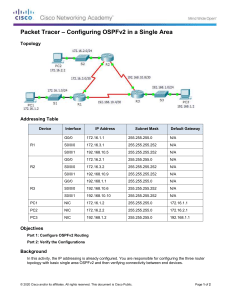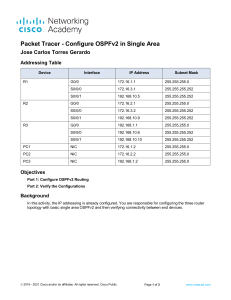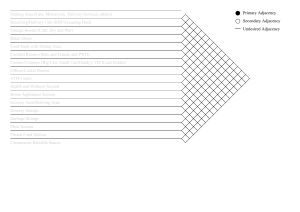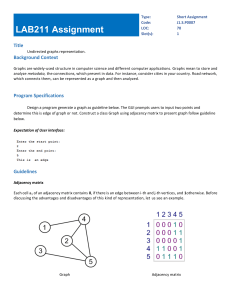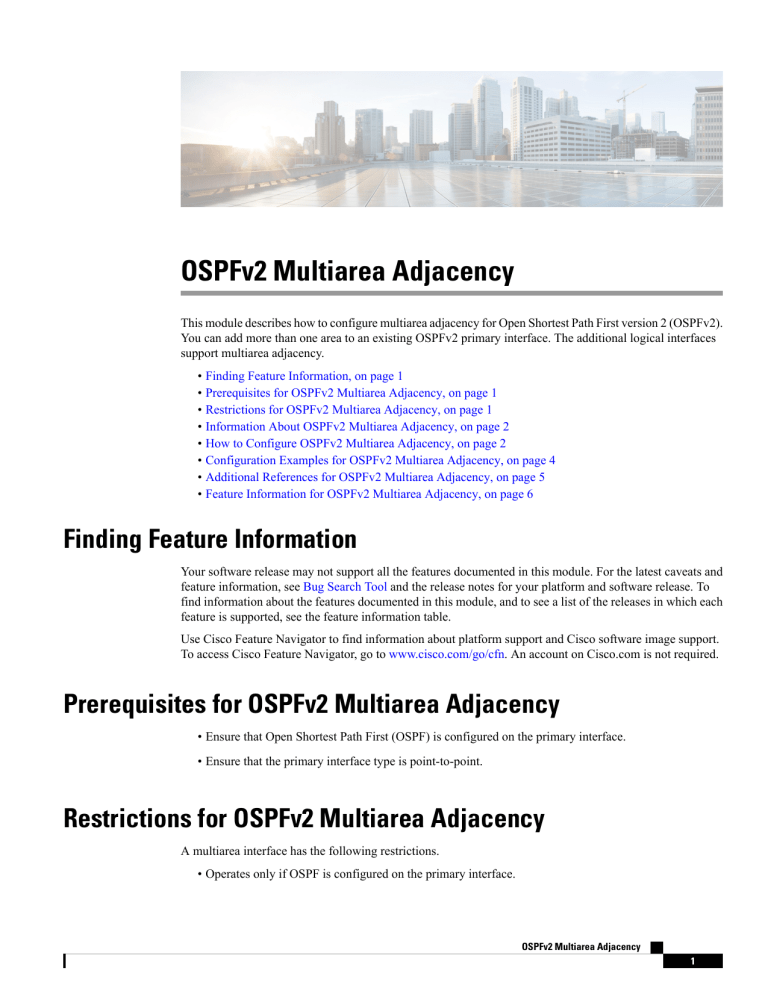
OSPFv2 Multiarea Adjacency This module describes how to configure multiarea adjacency for Open Shortest Path First version 2 (OSPFv2). You can add more than one area to an existing OSPFv2 primary interface. The additional logical interfaces support multiarea adjacency. • Finding Feature Information, on page 1 • Prerequisites for OSPFv2 Multiarea Adjacency, on page 1 • Restrictions for OSPFv2 Multiarea Adjacency, on page 1 • Information About OSPFv2 Multiarea Adjacency, on page 2 • How to Configure OSPFv2 Multiarea Adjacency, on page 2 • Configuration Examples for OSPFv2 Multiarea Adjacency, on page 4 • Additional References for OSPFv2 Multiarea Adjacency, on page 5 • Feature Information for OSPFv2 Multiarea Adjacency, on page 6 Finding Feature Information Your software release may not support all the features documented in this module. For the latest caveats and feature information, see Bug Search Tool and the release notes for your platform and software release. To find information about the features documented in this module, and to see a list of the releases in which each feature is supported, see the feature information table. Use Cisco Feature Navigator to find information about platform support and Cisco software image support. To access Cisco Feature Navigator, go to www.cisco.com/go/cfn. An account on Cisco.com is not required. Prerequisites for OSPFv2 Multiarea Adjacency • Ensure that Open Shortest Path First (OSPF) is configured on the primary interface. • Ensure that the primary interface type is point-to-point. Restrictions for OSPFv2 Multiarea Adjacency A multiarea interface has the following restrictions. • Operates only if OSPF is configured on the primary interface. OSPFv2 Multiarea Adjacency 1 OSPFv2 Multiarea Adjacency Information About OSPFv2 Multiarea Adjacency • Exists as a logical construct over a primary interface for OSPF; however, the neighbor state on the primary interface is independent of the multiarea interface. • Establishes a neighbor relationship with the corresponding multiarea interface on the neighboring device. A mixture of multiarea and primary interfaces is not supported. • Advertises an unnumbered point-to-point link in the device link-state advertisement (LSA) for the corresponding area when the neighbor state is full. • Inherits all the OSPF parameters (such as, authentication) from the primary interface. You cannot configure the parameters on a multiarea interface; however, you can configure the parameters on the primary interface. Information About OSPFv2 Multiarea Adjacency OSPFv2 Multiarea Adjacency Overview The Open Shortest Path First (OSPF) protocol allows you to divide a network topology into separate areas. The interface on which OSPF is configured belongs to only one area at any given point of time. This causes suboptimal routing for certain topologies, due to intra-area route preference over the interarea routes. Open Shortest Path First version 2 (OSPFv2) allows a single physical link to be shared by multiple areas. This creates an intra-area path in each of the corresponding areas sharing the same link. All areas have an interface on which OSPF is configured. One of these interfaces is designated as the primary interface and others as secondary interfaces. The OSPFv2 Multiarea Adjacency feature allows you to configure a link on the primary interface to enable optimized routing in multiple areas. Each multiarea interface is announced as a point-to-point unnumbered link. The multiarea interface exists as a logical construct over an existing primary interface. The neighbor state on the primary interface is independent of the neighbor state of the multiarea interface. The multiarea interface establishes a neighbor relationship with the corresponding multiarea interface on the neighboring device. You can only configure multiarea adjacency on an interface that has two OSPF speakers. In case of native broadcast networks, the interface must be configured as an OSPF point-to-point type to enable the interface for multiarea adjacency. Use the ip ospf multi-area command to configure multiarea adjacency on the primary OSPFv2 interface. How to Configure OSPFv2 Multiarea Adjacency Configuring OSPFv2 Multiarea Adjacency SUMMARY STEPS 1. 2. 3. 4. enable configure terminal interface type number ip address ip-address mask OSPFv2 Multiarea Adjacency 2 OSPFv2 Multiarea Adjacency Configuring OSPFv2 Multiarea Adjacency 5. 6. 7. 8. 9. ip ospf proces-id area area-id ip ospf network point-to-point ip ospf multi-area multi-area-id ip ospf multi-area multi-area-id cost interface-cost end DETAILED STEPS Step 1 Command or Action Purpose enable Enables privileged EXEC mode. Example: • Enter your password if prompted. Device> enable Step 2 configure terminal Enters global configuration mode. Example: Device# configure terminal Step 3 interface type number Example: Specifies an interface and enters interface configuration mode. Device(config)# interface Ethernet 0/0 Step 4 ip address ip-address mask Assigns an IP address to this interface. Example: Device(config)# ip address 10.0.12.1 255.255.255.0 Step 5 ip ospf proces-id area area-id Example: Device (config-if)# ip ospf 10 area 8 Configures the primary OSPF interface. • The process-id argument identifies the OSPF process. The range is from 1 to 65535. • The area-id argument identifies the OSPF area. The range is from 0 to 4294967295, or you can use an IP address. Step 6 ip ospf network point-to-point Specifies the primary interface type as point-to-point. Example: Device (config-if)# ip ospf network point-to-point Step 7 ip ospf multi-area multi-area-id Example: Device (config-if)# ip ospf multi-area 11 Step 8 ip ospf multi-area multi-area-id cost interface-cost Example: Configures multiarea adjacency on the interface. • The multi-area-id argument identifies the OSPF multiarea. The range is from 0 to 4294967295, or you can use an IP address. (Optional) Specifies the cost of sending a packet on an Open Shortest Path First (OSPF) multiarea interface, Device (config-if)# ip ospf multi-area 11 cost 10 OSPFv2 Multiarea Adjacency 3 OSPFv2 Multiarea Adjacency Configuration Examples for OSPFv2 Multiarea Adjacency Step 9 Command or Action Purpose end Exits interface configuration mode and returns to privileged EXEC mode. Example: Device(config-if)# end Configuration Examples for OSPFv2 Multiarea Adjacency Example: Configuring OSPFv2 Multiarea Adjacency Device# enable Device# configure terminal Device(config)# interface Ethernet 0/0 Device (config-if)# ip address 10.0.12.1 255.255.255.0 Device (config-if)# ip ospf 1 area 0 Device (config-if)# ip ospf network point-to-point Device (config-if)# ip ospf multi-area 2 Device (config-if)# ip ospf multi-area 2 cost 10 Device (config-if)# end The following is a sample output from the show ip ospf 2 multi-area command. Device# show ip ospf 2 multi-area OSPF_MA1 is up, line protocol is up Primary Interface Ethernet0/0, Area 2 Interface ID 2 MTU is 1500 bytes Neighbor Count is 1 The following is a sample output from the show ip ospf interface command. Device# show ip ospf interface Ethernet0/0 is up, line protocol is up Internet Address 10.0.12.1/24, Area 0, Attached via Interface Enable Process ID 1, Router ID 10.0.0.2, Network Type POINT_TO_POINT, Cost: 10 Topology-MTID Cost Disabled Shutdown Topology Name 0 10 no no Base Enabled by interface config, including secondary ip addresses Transmit Delay is 1 sec, State POINT_TO_POINT Timer intervals configured, Hello 10, Dead 40, Wait 40, Retransmit 5 oob-resync timeout 40 Hello due in 00:00:06 Supports Link-local Signaling (LLS) Cisco NSF helper support enabled IETF NSF helper support enabled Can be protected by per-prefix Loop-Free FastReroute Can be used for per-prefix Loop-Free FastReroute repair paths Index 2/2, flood queue length 0 Next 0x0(0)/0x0(0) Last flood scan length is 1, maximum is 1 Last flood scan time is 0 msec, maximum is 0 msec Neighbor Count is 1, Adjacent neighbor count is 1 Adjacent with neighbor 10.0.0.1 Suppress hello for 0 neighbor(s) Multi-area interface Count is 1 OSPF_MA1 interface exists in area 2 Neighbor Count is 1 OSPFv2 Multiarea Adjacency 4 OSPFv2 Multiarea Adjacency Additional References for OSPFv2 Multiarea Adjacency OSPF_MA1 is up, line protocol is up Interface is unnumbered. Using address of Ethernet0/0 (10.0.12.1), Area 2, Attached via Multi-area Process ID 1, Router ID 10.0.0.2, Network Type POINT_TO_POINT, Cost: 10 Topology-MTID Cost Disabled Shutdown Topology Name 0 10 no no Base Transmit Delay is 1 sec, State POINT_TO_POINT Timer intervals configured, Hello 10, Dead 40, Wait 40, Retransmit 5 oob-resync timeout 40 Hello due in 00:00:06 Supports Link-local Signaling (LLS) Cisco NSF helper support enabled IETF NSF helper support enabled Can be protected by per-prefix Loop-Free FastReroute Can be used for per-prefix Loop-Free FastReroute repair paths Index 1/3, flood queue length 0 Next 0x0(0)/0x0(0) Last flood scan length is 1, maximum is 2 Last flood scan time is 0 msec, maximum is 0 msec Neighbor Count is 1, Adjacent neighbor count is 1 Adjacent with neighbor 10.0.0.1 Suppress hello for 0 neighbor(s) Additional References for OSPFv2 Multiarea Adjacency Related Documents Related Topic Document Title Cisco IOS commands Cisco IOS Master Command List, All Releases OSPF commands Cisco IOS IP Routing: OSPF Command Reference Protocol-independent features that work with “Configuring IP Routing Protocol-Independent Features” OSPF module RFCs RFC Title RFC 5185 OSPF Multi-Area Adjacency, May 2008 Technical Assistance Description Link The Cisco Support and Documentation website provides http://www.cisco.com/cisco/web/support/index.html online resources to download documentation, software, and tools. Use these resources to install and configure the software and to troubleshoot and resolve technical issues with Cisco products and technologies. Access to most tools on the Cisco Support and Documentation website requires a Cisco.com user ID and password. OSPFv2 Multiarea Adjacency 5 OSPFv2 Multiarea Adjacency Feature Information for OSPFv2 Multiarea Adjacency Feature Information for OSPFv2 Multiarea Adjacency The following table provides release information about the feature or features described in this module. This table lists only the software release that introduced support for a given feature in a given software release train. Unless noted otherwise, subsequent releases of that software release train also support that feature. Use Cisco Feature Navigator to find information about platform support and Cisco software image support. To access Cisco Feature Navigator, go to www.cisco.com/go/cfn. An account on Cisco.com is not required. Table 1: Feature Information for OSPFv2 Multiarea Adjacency Feature Name Releases Feature Information OSPFv2 Multiarea Adjacency Cisco IOS XE Release 3.10S OSPFv2 multiarea adjacency allows you to configure a link on the primary interface in multiple OSPF areas to enable optimized routing. The following commands were introduced or modified: ip ospf multi-area, ip ospf multi-area cost, and show ip ospf multi-area. OSPFv2 Multiarea Adjacency 6
